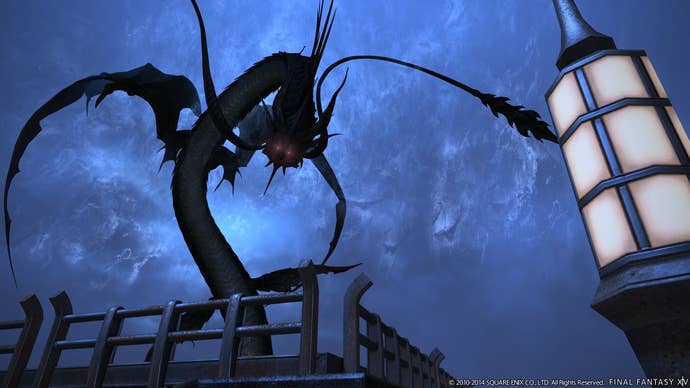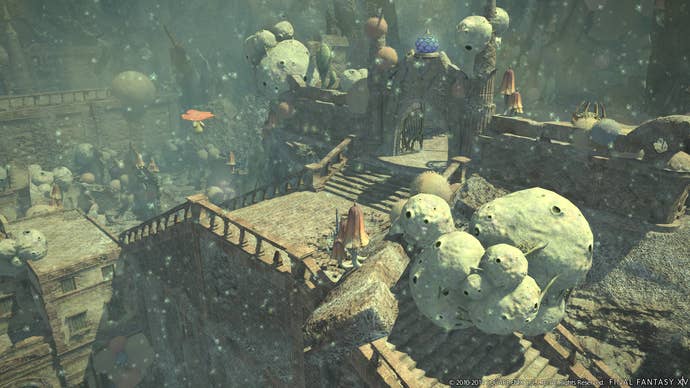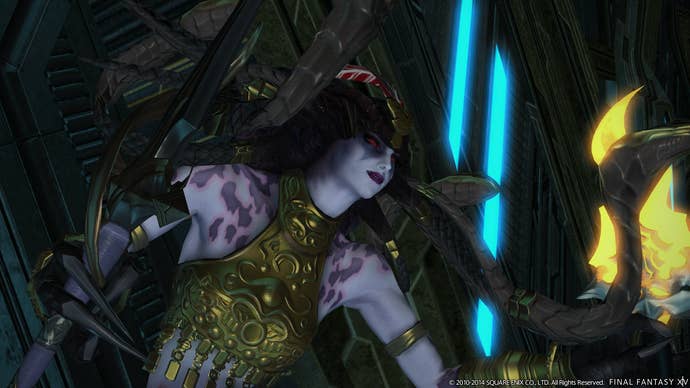Through the Maelstrom: How Final Fantasy XIV Keeps Adventurers Coming Back for More
Square Enix's rebooted MMO Final Fantasy XIV: A Realm Reborn just recently saw its second major content update. Can the game keep players interested in the long-term? Judging by the strength of this content, absolutely.
This article first appeared on USgamer, a partner publication of VG247. Some content, such as this article, has been migrated to VG247 for posterity after USgamer's closure - but it has not been edited or further vetted by the VG247 team.
"Games as a service" is one of those buzzwords that occasionally floats around the industry without anyone really being able to pin down what it means.
Most commonly, it's applied to free-to-play games, with the implication being that these "service" games are never-ending experiences designed to keep players playing (and paying) into perpetuity. But the concept has been around for a lot longer than that in the form of traditional, subscription-based MMOs, since these games need to provide a continual, ongoing stream of content. If they don't, those who reach the level cap and exhaust all the available content will simply jump ship and play something else instead; if they do, however, they'll build a loyal fanbase of people who are more than happy to keep paying those predictable fees every month.
So far, Naoki Yoshida and the Final Fantasy XIV: A Realm Reborn team have been doing an excellent job. Last Thursday saw the release of Through the Maelstrom, the second major content update for A Realm Reborn, and with it came not only plenty of excited players who had been enjoying the game since launch -- myself included -- but also an influx of lapsed players who wanted to try out the new challenges for themselves. And if the game continues to be updated with such significant content every three months, as is the plan, then A Realm Reborn can look forward to a very long and healthy lifespan indeed.
It's All About the Endgame

If you've never played an MMO before, the concept of the "endgame" can be a baffling one, but it's an extremely important aspect of the experience as a whole -- and one that is seemingly very easy to get wrong.
For the unfamiliar, the "endgame" of an MMO refers to what happens when your character reaches the level cap -- what do they do next? It's extremely important to cater to endgame players with content updates because they're the ones who need new content; those working their way up through the levels already, in most cases, have everything they need to make it to the cap.
In A Realm Reborn, endgame players have always had a number of different options: finish the "main scenario" quests and beat the "final" boss of the game; begin gathering the special "tomestones" currency to purchase high-level equipment by taking on high-level dungeons; take on the "Hard Mode" incarnations of the powerful Primal bosses from the main story; or simply switch to another class and begin the levelling process all over again, albeit with a considerably accelerated rate of experience point gain.
In practice, most players tend to juggle numerous different things to keep their play sessions interesting. For example, I currently have the Black Mage and White Mage battle classes up to 50 as well as the Miner gathering class and the Weaver crafting class. I'm currently working on levelling Paladin to 50 so I can have one of each of the "holy trinity" -- tank, healer, damage dealer -- available to run content with friends and strangers alike, but when I'm not doing that, I'm working my way through endgame content in order to make my White and Black Mages as powerful as they can possibly be.
If there's not enough endgame content available, the latter aspect can quickly get dull. It can be fun to see how quickly you can speedrun dungeons or take down the Primal bosses, but after a while, if there isn't something new and fun to do or a significant challenge to overcome, anyone will lose interest. And it's here where A Realm Reborn is doing particularly well.
The Next Episode

The first thing most players will do upon reaching level 50 in A Realm Reborn is finish off the main scenario quest, which pits them against the fearsome Ultima Weapon in a battle to determine the fate of all of Eorzea. After succeeding in this task, there's an end sequence, complete with half-hour credit roll, but the game doesn't end. In A Realm Reborn's initial incarnation, there was a selection of "post-game" content to take on, but the main story was done and dusted.
This changed with A Realm Awoken, the first major content patch for the game. The main scenario continued with a sequence of story-based quests that led the narrative's main cast on a journey to a new home and culminated in a spectacularly bizarre boss battle against Good King Moggle Mog XII, a giant moogle with a fantastic theme song. Through the Maelstrom continues the narrative further, introducing some new characters and teasing some potential future class options (it looks like Thief and/or Ninja is coming next) as well as providing another spectacular new foe to fight, in this case the Primal Leviathan. Who knows what's coming in future episodes? My money's on Ramuh.
But it's not just the main scenario that continues in an episodic manner; A Realm Awoken introduced (or, for players of FFXIV 1.0, re-introduced) the "gentleman hero" Hildibrand, an incompetent private investigator whom your character becomes entangled with, and Through the Maelstrom continues his story up to and including a hilarious clash with Final Fantasy V's Gilgamesh on, yes, a big bridge.
For those who found themselves particuarly enjoying Final Fantasy XIV for its authentically "Final Fantasy" narrative, these additional episodes will provide plenty of incentive to come back, particularly as their most spectacular moments -- the Moggle Mog, Leviathan and Gilgamesh battles -- are repeatable whenever you want.
Hey, I Worked Hard for That

For those more focused on character progression than the continuing narrative, though, there's still plenty to do. There's been an overall increase in the maximum possible item level that characters are able to equip, and certain items that were a challenge to get in the original A Realm Reborn are now significantly easier to obtain.
The biggest change in Through the Maelstrom is the retirement of Allagan Tomestones of Philosophy, an endgame currency that was, for most players, their first passport into the world of equipment that exceeded their character level. The items formerly acquirable via "philo tomes," as they tended to be known, are now available as dungeon drops, with a new type of tomestone being introduced to gate access to the very best equipment. It's still a challenge to get hold of these items; there's just been a shift in terms of how you do so, and this is likely to continue in future patches as Yoshida and the team are keen to ensure endgame players are able to get into the latest and greatest content quickly.
Another significant change comes in the form of the Zodiac Weapons quest, which follows the existing A Relic Reborn quest, undertaken by most players after they complete the main story. The Relic quest outfits players with a powerful weapon for their class that can subsequently be upgraded, and is a relatively straightforward process. The Zodiac Weapons quest, meanwhile, is a much more lengthy affair that requires the acquisition of twelve special "Atma" items from around the realm, and the only way you can collect these is by participating in FATEs, public quests that pop up in each zone every so often. Completing a FATE with a gold ranking has a roughly 5% chance that you'll acquire the Atma you require, so in most cases you'll need to participate in a whole lot of these FATEs to collect the items in question.
This may sound like a grind -- and it is -- but it's also there for game design reasons. FATEs use to be the most reliable means of gathering experience quickly in the game, but were supplanted by dungeons in A Realm Awoken thanks to greatly improved rewards. What the Zodiac Weapons quest has done is make FATEs relevant again; the constant, long-term searching for Atmas means that it's now very rare you'll come across a FATE that doesn't have at least a few people participating, whereas for a while many areas had become somewhat barren due to the fact everyone was dungeon-crawling instead.
A Matter of Choice

By far the most important thing Yoshida and the team are doing with each major new update to Final Fantasy XIV, though, is providing players with more and more choice as to what they want to do. Endgame players have more and more choice as to which of the increasingly large roster of dungeons they would like to run or Primals they would like to fight; lower-level players have a broader selection of sidequests to take on to help speed their levelling along. There's never a situation where there's only one thing -- or, worse, nothing -- available for you to do at any given point in time. There's always a choice.
This matter of choice extends to customization, too. Whereas previously all players of the same level tended to look almost identical due to the fact everyone was more than likely wearing the same equipment, the new Glamours system allows players to customize the appearance of any of their equipped items to match something else they own. This allows players to express themselves more freely through the way their character dresses, and also to make themselves stand out in a crowd -- always a plus in a game so dependent on playing with others. It also provides an incentive to level a crafting class, since the various Glamour Prisms required to enchant the appearance of your equipment can only be produced by crafters -- they aren't available to buy anywhere except the player-driven Market Board.
More than anything, though, the changes and additions in Through the Maelstrom, while not always as successful as they perhaps could have been -- the Zodiac Weapons quest in particular is the source of considerable frustration to many players thanks to the Atmas' agonizingly low drop rate -- prove that Yoshida and the team are keen to not only make A Realm Reborn as good as it possibly can be, but to make Eorzea into a living, breathing virtual world that will persist for many years to come. And not only that, they're keen to listen to and respond to feedback, too; many of the changes that have come about in recent patches are in direct response to community feedback, and the game has become a better experience for everyone as a result.
That, then, is what games as a service are all about; providing an ongoing, constantly evolving, improving experience designed to keep you hooked for a very long time indeed. And if Yoshida and company continue to provide such significant updates on such a regular basis, I can see myself being an inhabitant of Eorzea for many years to come yet.
Don't forget the PlayStation 4 version of Final Fantasy XIV launches in April; it's a great opportunity to take your first steps in the reborn realm of Eorzea. See you there!








